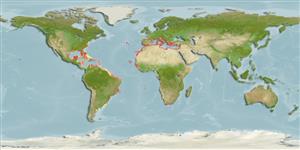Common names from other countries
Environment: milieu / climate zone / depth range / distribution range
Ecologia
; intervalo de profundidade 0 - 26 m (Ref. 83435). Subtropical
Eastern Central Atlantic and the Mediterranean Sea: Cape Verde Island to Congo.
Length at first maturity / Tamanho / Peso / Idade
Maturity: Lm ? range ? - ? cm Max length : 56.5 cm SHL macho/indeterminado; (Ref. 83435); common length : 40.0 cm SHL macho/indeterminado; (Ref. 437)
Minimum depth from Ref. 104365.
Life cycle and mating behavior
Maturidade | Reprodução | Desova | Ovos | Fecundidade | Larvas
Members of the class Bivalvia are mostly gonochoric, some are protandric hermaphrodites. Life cycle: Embryos develop into free-swimming trocophore larvae, succeeded by the bivalve veliger, resembling a miniature clam.
Fischer, W., G. Bianchi and W.B. Scott (eds.). 1981. (Ref. 437)
Categoria na Lista Vermelha da IUCN (Ref. 130435: Version 2024-1)
Categoria CITES (Ref. 108899)
Not Evaluated
Not Evaluated
Utilização humana
| FishSource |
Ferramentas
Fontes da internet
Estimates based on models
Preferred temperature
(Ref.
115969): 17.8 - 27.3, mean 21.4 (based on 1146 cells).
Vulnerabilidade
High vulnerability (64 of 100).
Categoria de preço
Unknown.
